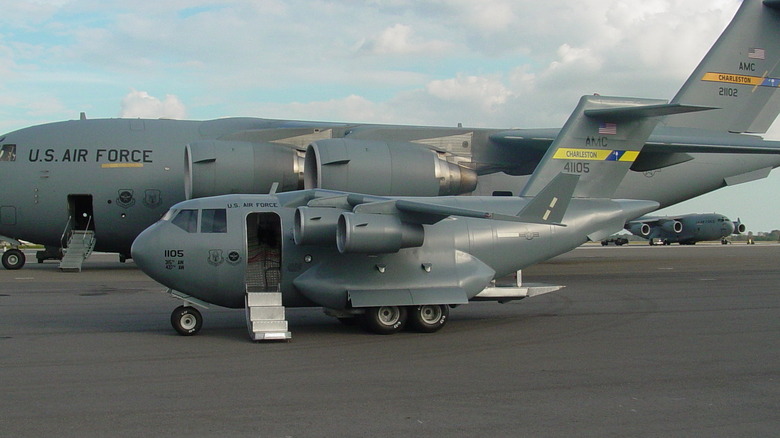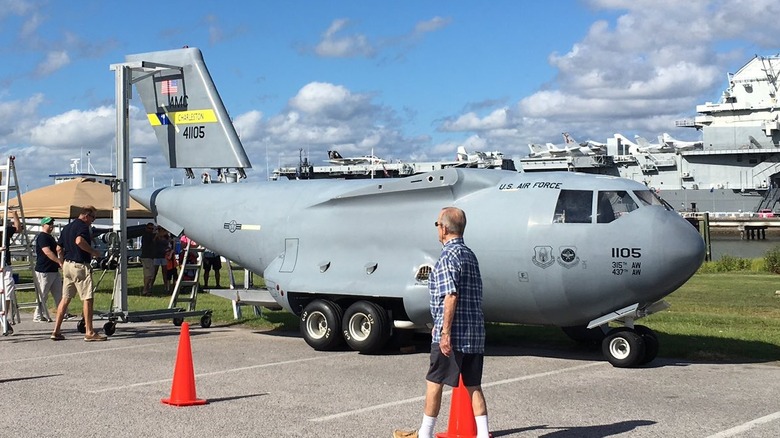Can The US Military's Mini C-17 Fly? Here's What It's Used For
The U.S. Air Force is known for operating some of the most advanced and powerful aircraft in the world. Among them is the C-17 Globemaster III, a heavy-duty transport jet built to move troops and equipment across continents. But not every mission involves taking to the skies. One of the Air Force's most charming assets stays firmly on the ground — a tiny, cartoonishly proportioned version of the C-17 that looks like something straight out of a Pixar film.
But could it take to the skies if the Air Force really gave it a shot? One glance at the plane's stubby fuselage and comically short wings makes the answer pretty clear. The wings and the four tiny engine pods are all just for show, though it can drive at speeds up to 15 miles per hour.
Still, the story of its creation is an interesting one. The concept was first floated way back in 1999, though construction didn't begin until 2002. The task was undertaken entirely by a team of volunteers from the 315th and 437th Airlift Wings at Joint Base Charleston. One officer described it as a "true monster garage" project to Task & Force.
After all, the entire structure was built around the bones of a donated John Deere Gator utility vehicle, with castoff scrap materials being used to shape the fuselage. The project also served as a fantastic training opportunity for younger maintenance personnel to practice their sheet metal skills. The creators didn't skimp on the details either: the plane features mock flight station panels, authentic engine sounds, and a fully operational cargo ramp and door.
Looks like a jet, works in public relations
When the mini C-17 was unveiled in November 2004 following 23 months of construction, its appearance was so convincing to some in the audience that they reportedly inquired about what they thought was a new type of aircraft. The product was officially named the "Spirit of Hope, Liberty & Freedom." It is a roughly one-sixth scale model of the real deal. Specifically, it measures 32 feet in length, stands 13.4 feet tall, has a 28.5-foot wingspan, and weighs 3,500 pounds. Perhaps that's why transporting the vehicle is a significant undertaking and requires a custom 44-foot-long NASCAR-style trailer. Assembly at each event is also an all-hands-on-deck process that takes a crew about an hour to complete. Disassembly takes another hour and a half.
So why go through all this trouble? While the full-sized C-17, long since discontinued by Boeing, is busy hauling payloads like tanks and helicopters across continents, the baby version serves a much different mission on the home front. It was conceived as a special communications and recruiting tool for the Air Force Reserve. It's currently a star attraction at community events, parades, air shows, and even ball games. It's also made appearances across the United States, including in places like the Pentagon's courtyard. Better yet, it's even hitched a ride in a real C-17 across the Atlantic to Yeovilton, England, where it won the "Best Static Display" award at a 2016 airshow.
That said, this adorable behemoth isn't alone — the Air Force actually has a whole "patchwork fleet" of similar models. These include at least three different mini C-130 Hercules replicas operated by various Air National Guard units. Various recruiting squadrons also make use of mini F-16s and F-22 Raptors. So next time you're at an airshow, be on the lookout for one of these tiny planes.

